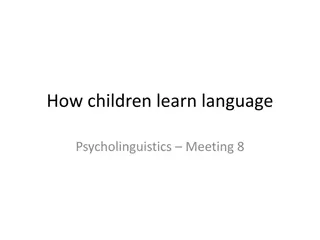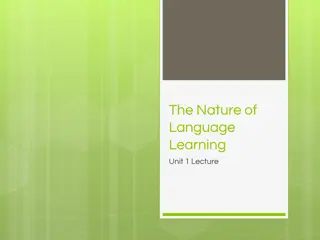Insights into Second Language Acquisition and Learning
Understanding the processes of second language acquisition and learning, including the differences between unconscious acquisition and conscious learning, barriers encountered, impact of early experience and age, affective factors like self-consciousness, and teaching methods like the Grammar-Translation method.
Download Presentation

Please find below an Image/Link to download the presentation.
The content on the website is provided AS IS for your information and personal use only. It may not be sold, licensed, or shared on other websites without obtaining consent from the author.If you encounter any issues during the download, it is possible that the publisher has removed the file from their server.
You are allowed to download the files provided on this website for personal or commercial use, subject to the condition that they are used lawfully. All files are the property of their respective owners.
The content on the website is provided AS IS for your information and personal use only. It may not be sold, licensed, or shared on other websites without obtaining consent from the author.
E N D
Presentation Transcript
Second Language Second Language Acquisition / Acquisition / Learning Learning
Unconsciously Acquisition first normal language
Consciously Learning intentional second/foreign
Acquisition Barriers Even in ideal acquisition situations, very few adults seem to reach native-like proficiency in using second language. There are individuals who can achieve great expertise in the written language , but not the spoken language .
- Early experience in using the sounds and intonation of the second language, - Inherent capacity for language strongly taken over by being features of first language with loss of flexibility to receive the features of another language.
Students in their early teens are quicker second language learners ( 7 years ). The optimum age for learning may be during 10 16 years ( inherent capacity , maturation of cognitive skills )
Affective Factors Affective Factors Teenagers are more self-conscious than younger children. Embarrassment in attempting to produce the different sounds of another language and lack of empathy can be other barriers for learning .
Affective factors may also include : dull textbooks , unpleasant classroom surroundings , exhausting schedule of study . If we are stressed , uncomfortable , self- conscious or unmotivated , we are unlikely to learn anything .
Grammar Grammar- -Translation Method Translation Method - lists of vocabulary - sets of grammar- memorization is encouraged - written rather than spoken is emphasized - learning about the language is emphasized and not how to use it
The Audiolingual Method - spoken language is emphasized - drills that student had to repeat - habits that could be developed by a lot of practice
Communicative Approaches Communicative Approaches functions of language should be emphasized rather than the forms of language. ex: - asking for things - telling the way - apologizing
Focus on the learner Focus on the learner - Shift from concern with teacher , textbook and the method to an interest in the learner and the acquisition process. - Toleration of errors produced by learners
Transfer Transfer refers to speakers or writers applying knowledge from their native language to a second language. It can occur in any situation when someone does not have a native-level command of a language, as when translating into a second language.
Ex: In Arabic, noun adjective in English , adjective noun *book good good book
Interlanguage It is the term for a dynamic linguistic system that has been developed by a learner of a second language who has not become fully proficient yet but is approximating the target language: preserving some features of their first language or overgeneralizing target language rules in speaking or writing the target language and creating innovations.
The type of language (or linguistic system) used by second- andforeign- language learners who are in the process of learning a target language.
Motivation It is the psychological quality that leads people to achieve a goal. For language learners, mastery of a language may be a goal. It can be instrumental and/or integrative.
Input and Output input refers to the language that the is exposed to . It has to be comprehensible by being simpler in structure and vocabulary. Negotiated input refers to second language material that the learner can acquire in interaction through request for clarification while active attention is being focused on what is said .
Comprehensible output could be an important element in the learner s development of second language ability. Task-based learning refers to different types of tasks and activities in which learners have to interact with each other.
Communicative Competence It is the general ability to use language accurately, appropriately and flexibly. Grammatical competence involves the accurate use of words and structures Sociolinguistic competence is the ability to use appropriate language. It enables the learner to know what is suitable to say according to the social context.
Strategic competence It is the ability to organize a message effectively and to compensate for any difficulties. Communication strategy happens when the second language learner tries to refer to the object( which the learner doesn t know in the target language) by using vocabulary already known























